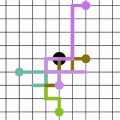Continuous-time quantum walks provide a natural framework to tackle the fundamental problem of finding a node among a set of marked nodes in a graph, known as spatial search. Whether spatial search by continuous-time quantum walk provides a quadratic advantage over classical random walks has been an outstanding problem. Thus far, this advantage is obtained only for specific graphs or when a single node of the underlying graph is marked. In this article, we provide a new continuous-time quantum walk search algorithm that completely resolves this: our algorithm can find a marked node in any graph with any number of marked nodes, in a time that is quadratically faster than classical random walks. The overall algorithm is quite simple, requiring time evolution of the quantum walk Hamiltonian followed by a projective measurement. A key component of our algorithm is a purely analog procedure to perform operations on a state of the form $e^{-tH^2}|\psi\rangle$, for a given Hamiltonian $H$: it only requires evolving $H$ for time scaling as $\sqrt{t}$. This allows us to quadratically fast-forward the dynamics of a continuous-time classical random walk. The applications of our work thus go beyond the realm of quantum walks and can lead to new analog quantum algorithms for preparing ground states of Hamiltonians or solving optimization problems.
翻译:连续时间量子漫步提供了一个自然框架, 以解决在图表中一组标记节点( 称为空间搜索) 中找到一个节点的基本问题。 连续时间量子漫步的空间搜索是否提供了相对于古典随机漫步的二次优势, 是一个尚未解决的问题 。 到目前为止, 这一优势只为特定图表获得, 或者当下图的单一节点被标出时, 我们提供一种新的连续时间量子漫步搜索算法, 完全解决这个问题 : 我们的算法可以在任何图中找到一个标记节点, 带有任何几个标记节点, 时间比经典随机行走的速度快。 总体算法非常简单, 需要数量漫步汉密尔顿行的时间演进, 然后进行预测性测量。 我们的算法的一个关键部分是纯粹的模拟程序, 以表的状态进行操作, $- h ⁇ 2\\\\\\\\\\\\\\\\\\\\\\\\\\\\\\\\\\\\\\\\\\\\\\\\\\\\\\\\\\\\\\\\\\\\\\\\\\\\\\\\\\\\\\\\\\\\\\\\\\\\\\\\\\\\\\\\\\"\\\\\\\\\\\\\\\\\\\\\\\\\\\\\\\\\\\\\\\\\\\\\\\\\\\\\\\\\\\\\\\\\\\\\\\\\\\\\\\\\\\\\\\\\\\\\\\\\\\\\\\\\\\\\\\\\\\\\\\\\\\\\\\\\\\\\\\\\\\\\\\\\\\\\\\\\\\\\\\\\\\\\\\\\\\\\\\\\\\\\\\\\\\\\\\\\\\\\\\\\\\\\\\



